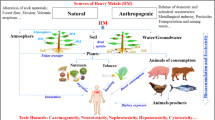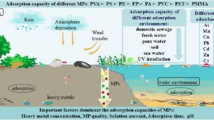Abstract
Recent studies have demonstrated the significant role of colloidal microparticles or macromolecules in the biogeochemical cycling of trace metals in aquatic environments. In this study, the influences of different colloidal organic carbon (COC) concentrations, colloidal sizes and colloidal origins (estuarine vs coastal) on the bioavailability of two trace metals (Cr and Fe) to the green mussel Perna viridis and the clam Ruditapes philippinarum were examined under laboratory conditions. Natural colloids were isolated by cross-flow ultrafiltration and were radiclabeled with 59Fe and 51Cr before being exposed to the mussels and clams. The uptake of colloid-bound Cr and Fe was compared with the uptake of low molecular weight complexed metals (<1 kDa). Both natural colloid-bound Cr and Fe were bioavailable to the green mussels and clams. The uptake of both colloidal Cr and Fe by the two bivalves was much higher than that of their counterparts in a low molecular weight fraction, implying that colloidal binding enhanced considerably the bioavailability of Cr and Fe to the bivalves. The magnitude to which Cr uptake was enhanced, due to its binding with colloids, was much greater than that of Fe. There was no significant difference in the measured dry weight concentration factor of the metals between the two COC concentrations. Similarly, the COC concentration did not influence metal uptake when all the experiments were considered together. There was generally no major difference in the metal bioavailability between the two different sizes of colloids isolated from the coastal waters (1–10 kDa and 10 kDa-0.2 μm), whereas metals bound with the larger size colloids isolated from the estuarine waters were more bioavailable than metals bound with the smaller size colloids. The bioavailability of Cr and Fe bound with the colloids from estuarine waters was generally lower than those bound with colloids from the coastal waters. This study demonstrated that the geochemical properties of colloids (origin) and the chemical properties of metals are critical in affecting the bioavailability of colloid-bound metals to marine bivalves.
Similar content being viewed by others
References
Aluwihare LI, Repeta DJ, Chen RF (1997) A major biopolymeric component to dissolved organic carbon in surface seawater. Nature 387:166–169
Bayne BL, Hawkins AJS, Navarro E (1987) Feeding and digestion by the mussel Mytilus edulis L. (Bivalvia: Mollusca) in mixtures of silt and aigal cells at low concentrations. J Exp Mar Biol Ecol 111:1–22
Bayne BL, Hawkins AJS, Navarro E, Iglesias IP (1989) Effects of seston concentration on feeding, digestion and growth in the mussel Mytilus edulis. Mar Ecol Prog Ser 55:47–54
Benner R, Pakulski JD, McCarthy M, Hedges JL, Hatcher PG (1992) Bulk chemical characteristics of dissolved organic matter in the ocean. Science 255:1561–1564
Buffle J, Leppard GG (1995a) Characterization of aquatic colloids and macromolecules. I. Structure and behavior of colloidal material. Environ Sci Technol 29:2169–2175
Buffle J, Leppard GG (1995b) Characterization of aquatic colloids and macromolecules. 2. Key role of physical structures on analytical results. Environ Sci Technol 29:2176–2184
Campbell PGC (1995) A critique of the free-ion activity model. In: Tessier A, Turner DR (eds) Metal speciation and bioavailability in aquatic systems. Wiley, Chichester, pp 45–102
Campbell PGC, Twiss MR, Wilkinson KJ (1997) Accumulation of natural organic matter on the surfaces of living cells: implications for the interaction of toxic solutes with aquatic biota. Can J Fish Aquat Sci 54:2543–2554
Carvalho RA, Benfield MC, Santschi PH (1999) Comparative bioaccumulation studies of colloidally complexed and free-ionic heavy metals in juvenile brown shrimp Penaeus aztecus (Crustacea: Decapoda: Penaeidae). Limnol Oceanogr 44:403–414
Chen M, Wang WX (2001) Bioavailability of natural colloidal-bound iron to marine plankton: influence of colloidal size and aging. Limnol Oceanogr 46:1956–1967
Chin WC, Orellana MV, Verdugo P (1998) Spontaneous assembly of marine dissolved organic matter into polymer gels. Nature 391:568–572
Chong K, Wang WX (2001) Comparative studies on the biokinetics of cadmium, chromium, and zinc in the green mussel Perna viridis and the Manila clam Ruditapes philippinarum. Environ Pollut 115:107–121
Engelhaupt E, Bianchi TS (2001) Sources and composition of high-molecular-weight dissoived organic carbon in a southern Louisiana tidal stream (Bayou Trepagnier). Limnol Oceanogr 46:917–926
Goldberg ED, Koide M, Hodge V, Flegal AR, Martin J (1983) U.S. mussel watch: 1977–1978 results on trace metals and radionuclides. Estuar Coast Shelf Sci 16:69–93
Guo LD, Santschi PH (1996) A critical evaluation of the cross-flow ultrafiltration technique for sampling colloidal organic carbon in seawater. Mar Chem 55:113–127
Guo LD, Santschi PH (1997) Composition and cycling of colloids in marine environments. Rev Geophys 35:17–40
Guo L, Coleman CH Jr, Santschi PH (1994) The distribution of colloidal and dissolved organic carbon in the Gulf of Mexico. Mar Chem 45:105–119
Guo LD, Santschi PH, Warnken KW (2000) Trace metal composition of colloidal organic material in marine environments. Mar Chem 70:257–275
Guo LD, Hunt BJ, Santschi PH, Ray SM (2001) Effect of dissolved organic matter on the uptake of trace metals by American oysters. Environ Sci Technol 35:885–893
Gustafsson O, Gschwend PM (1997) A quatic colloids: concepts. definitions, and current challenges. Limnol Oceanogr 42:519–528
Honeyman BD, Santschi PH (1991) Coupling adsorption and particle aggregation: laboratory studies of colloidal pumping using 59Fe-labeled hematite. Environ Sci Technol 25:1739–1747
Janes N, Playle RC (1995) Modeling silver binding to gills of rainbow trout (Oncorhynchus mykiss). Environ Toxicol Chem 14:1847–1858
Lee B-G, Wallace WG, Luoma SN (1998) Uptake and loss kinetics of Cd, Cr, and Zn in the bivalves Potamocorbula amurensis and Macoma balthica: effects of size and salinity. Mar Ecol Prog Ser 175:177–189
Martin JM, Dai MH, Cauwet G (1995) Significance of colloids in the biogeochemical cycling of organic carbon and trace metals in the Venice Lagoon (Italy). Limnol Oceanogr 40:119–131
Nieboer E, Richardson DH (1980) The replacement of the nondescript term ‘heavy metals’ by a biological and chemically significant classification of metal ions. Environ Pollut (Ser B) 1:3–26
Nishioka J, Takeda S, Wong CS, Johnson WK (2001) Size-fractionated iron concentrations in the northeast Pacific Ocean: distribution of soluble and colloidal iron. Mar Chem 74:157–179
Nodwell LM, Price NM (2001) Direct use of inorganic colloidal iron by marine mixotrophic phytoplankton. Limnol Oceanogr 46:765–777
O'Connor TP (1992) Recent trends in coastal environmental quality: results from the first live years of the NOAA mussel watch project. US Dept. Commerce, NOAA, National Ocean Service. Washington, DC
Rainbow PS (1993) Biomonitoring of marine heavy metal pollution and its application in Hong Kong waters. In: Morton B (ed) The marine biology of the South China Sea. Hong Kong University Press, Hong Kong, pp 235–250
Ranville JF, Schmiermund RL (1998) An overview of environmental colloids. In: Macalady DL (ed) Perspectives in environmental chemistry. Oxford University Press, New York, pp 25–56
Roditi HA, Fisher NS, Sanudo-Wilhelmy SA (2000) Uptake of dissolved organic carbon and trace elements by zebra mussels. Nature 407:78–80
Santschi PH, Balnois E, Wilkinson KJ, Zhang J, Buffle J, Guo L (1998) Fibrillar polysaccharides in marine macromolecular organic matter as imaged by atomic force microscopy and transmission electron microscopy. Limnol Oceanogr 43:896–908
Santschi PH, Guo LD, Means JC, Ravichandran M (1999) Natural organic matter binding of trace metals and trace organic contaminants in estuaries. In: Bianchi TS, Pennock JR, Twilley RR (eds) Biogeochemistry of Gulf of Mexico estuaries. Wiley, New York, pp 347–380
Sirinawin W, Turner DR, Westerlund S (2000) Chromium (VI) distributions in the Arctic and the Atlantic Oceans and a reassessment of the oceanic Cr cycle. Mar Chem 71:265–282
Tack JF, Polk P (1995) The uptake of colloidal melanin from seawater by marine bivalves. Mar Ecol 17:543–548
Viarengo A (1989) Heavy metals in marine invertebrates: mechanisms of regulation and toxicity at the cellular level. Rev Aquat Sci 1:295–317
Wang WX, Dei RCH (1999) Factors affecting trace element uptake in the black mussei Septifer virgatus. Mar Ecol Prog Ser 186:161–172
Wang WX, Guo LD (2000) Influences of natural colloids on metal bioavailability to two marine bivalves. Environ Sci Technol 34:4571–4576
Wang WX, Fisher NS, Luoma SN (1996) Kinetic determinations of trace element bioaccumulation in the mussel Mytilus edulis. Mar Ecol Prog Ser 140:91–113
Wells ML, Kozelka PB, Bruland KW (1998) The complexation of “dissolved” Cu, Zn, Cd and Pb by soluble and colloidal organic matter in Narragansett Bay. RI. Mar Chem 62:203–217
Wells ML, Smith GJ, Bruland KW (2000) The distribution of colloidal and particulate bioactive metals in Narragansett Bay. RI. Mar Chem 71:143–163
Wen LS, Santschi PH, Tang D (1997) Interactions between radioactively labeled colloids and natural particles: evidence for colloidal pumping. Geochim Cosmochem Acta 61:2867–2878
Wen LS, Santschi PH, Gill G, Paternostro C (1999) Estuarine trace metal distribution in Galveston Bay: importance of colloidal forms in the speciation of the dissolved phase. Mar Chem 63:185–212
Wu J, Boyle E, Sunda WG, Wen LS (2001) Soluble and colloidal iron in the oligotrophic North Atlantic and North Pacific. Science 293:847–849
Author information
Authors and Affiliations
Corresponding author
Additional information
Communicated by T. Ikeda, Hakodate
Published online: 21 June 2002
Rights and permissions
About this article
Cite this article
Pan, J.F., Wang, W.X. Comparison of the bioavailability of Cr and Fe bound with natural colloids of different origins and sizes to two marine bivalves. Marine Biology 141, 915–924 (2002). https://doi.org/10.1007/s00227-002-0875-9
Received:
Accepted:
Issue Date:
DOI: https://doi.org/10.1007/s00227-002-0875-9




